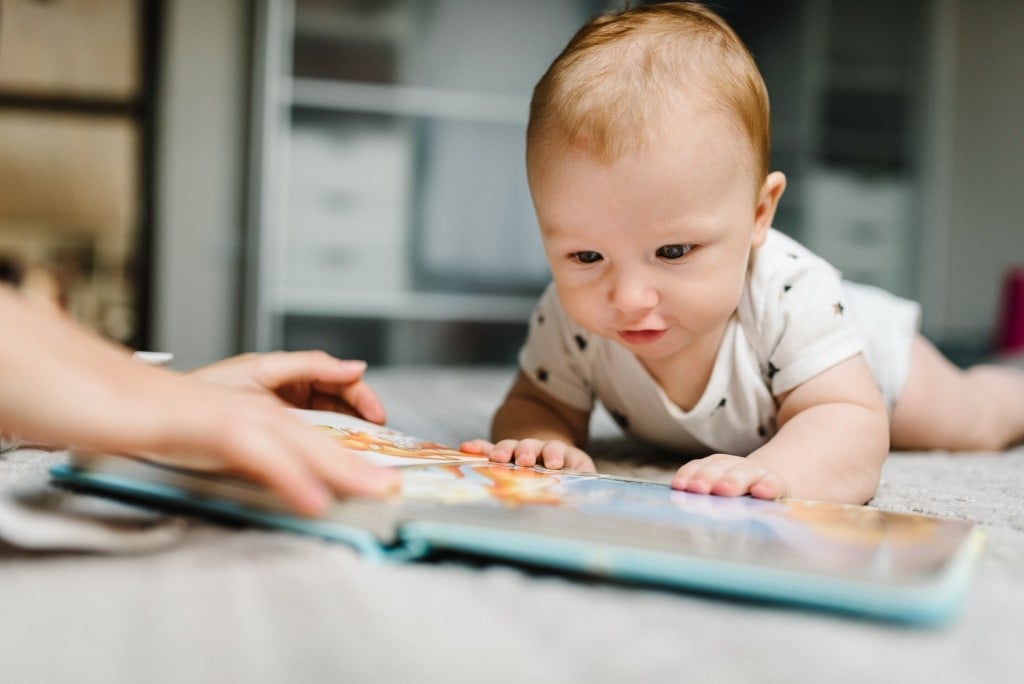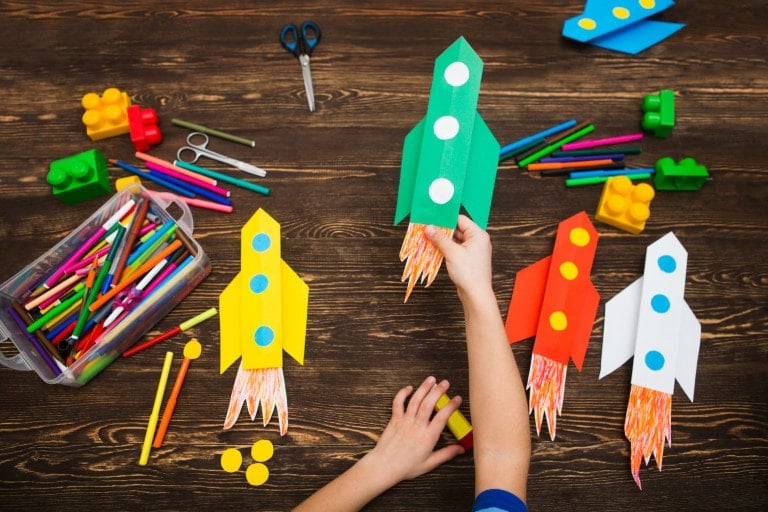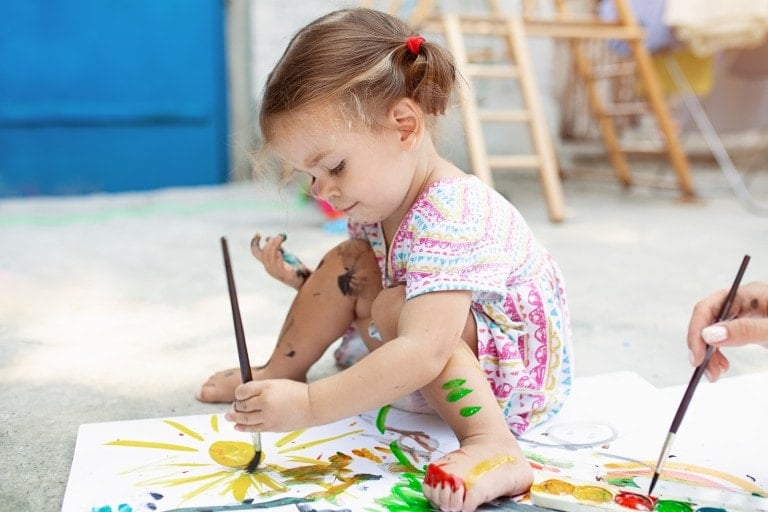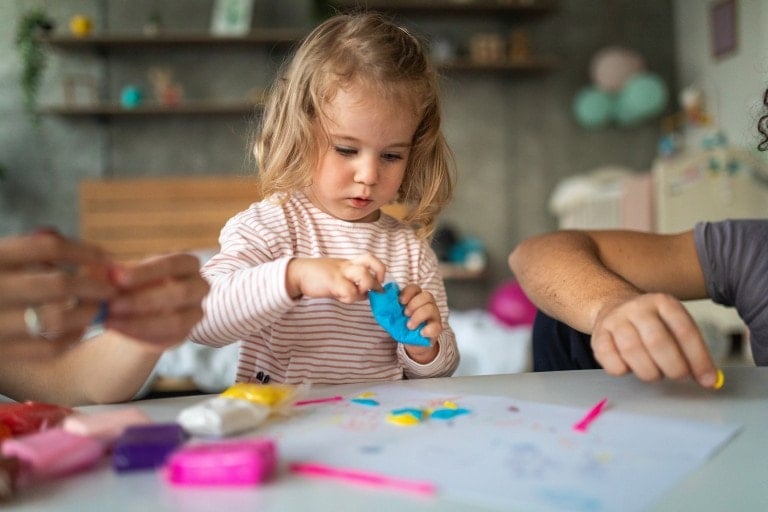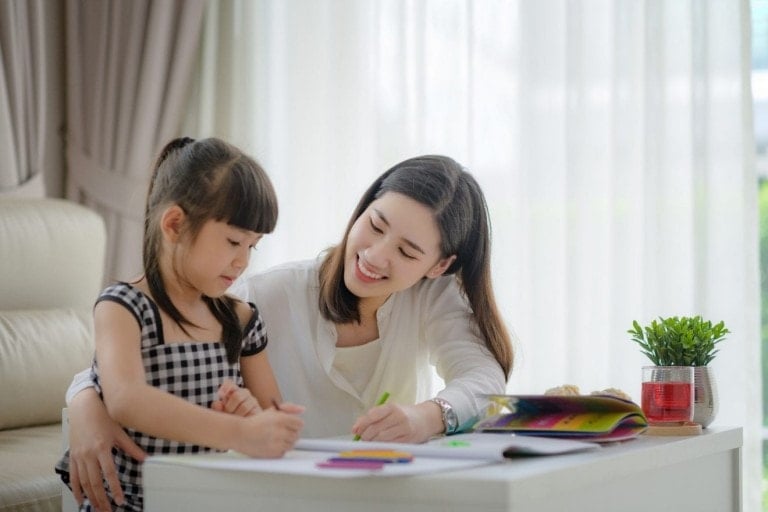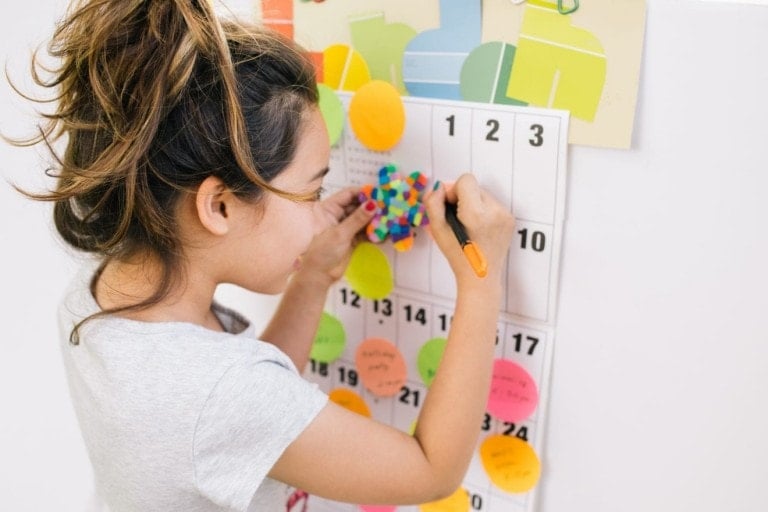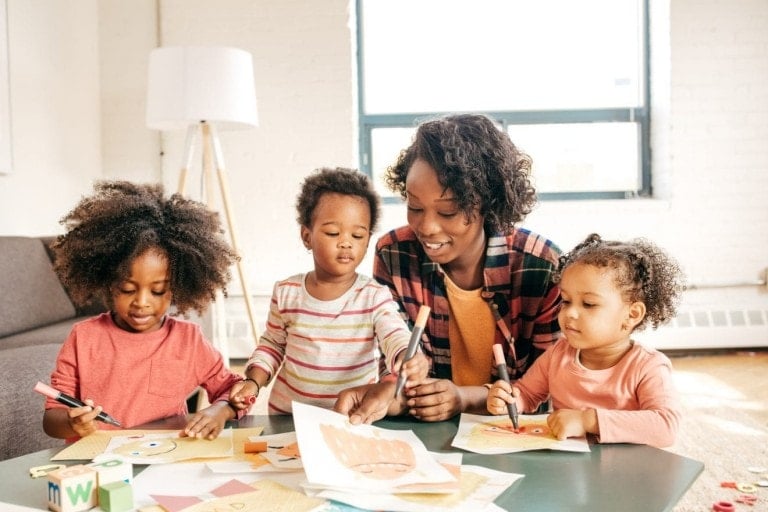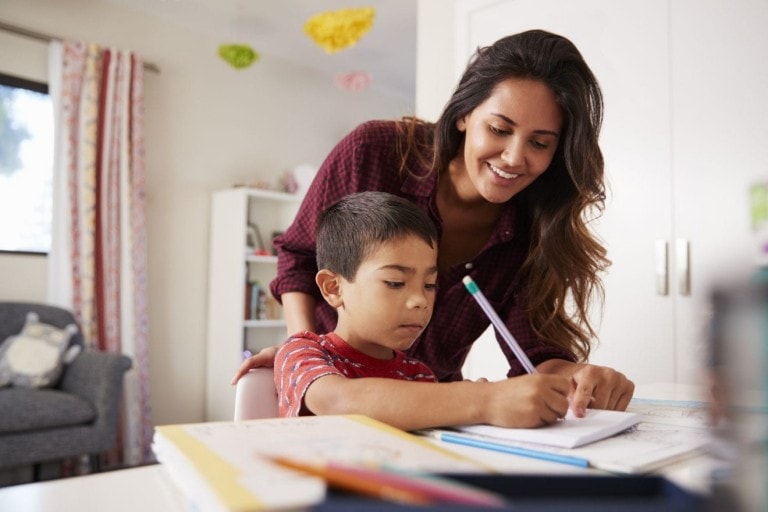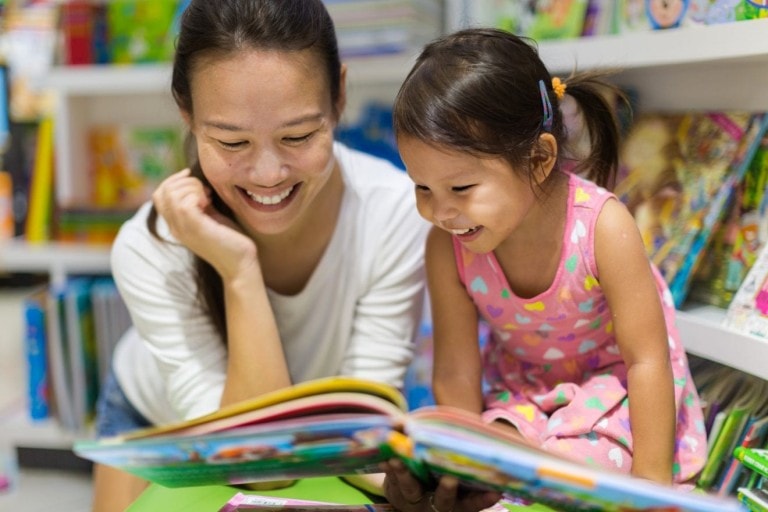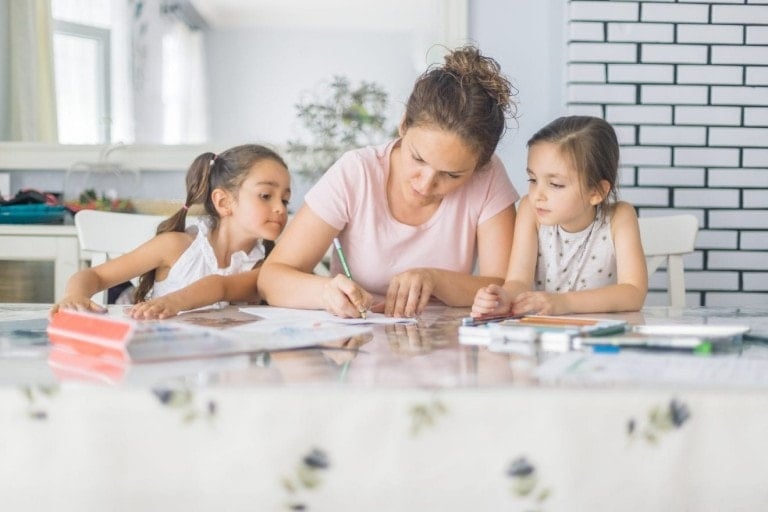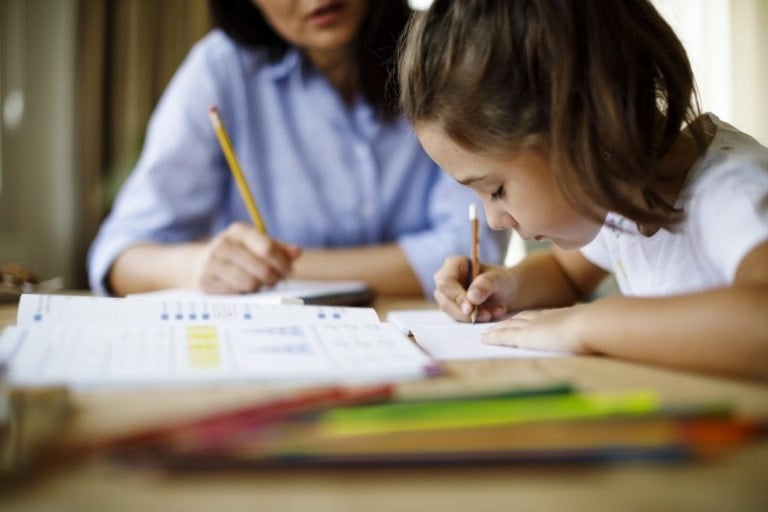Between the ages of 0 and 15 months, infants and young toddlers continually explore their surroundings and adapt to changes. Parents can facilitate development within this age group through guided learning opportunities at home.
As my son grew through this age group, we engaged in many learning opportunities that encompassed a variety of skills. For instance, my son would have the opportunity to explore books during tummy time. We would practice listening to the story, gaining familiarity with the story through repetition, exploring the pages with hands and fingers, and identifying what we saw by name. This activity worked on multiple skills from three different learning areas.
Creating Learning Opportunities at Home
Creating learning opportunities at home is as easy as observing what your child can do and recognizing the potential of what they could do with extra practice and/or encouragement. Important skills that can be referenced while creating learning opportunities at home during this stage include:
Language and Literacy
- Turns head or moves eyes toward a sound
- Shows brief interest in picture books
- Makes vocalizations that vary depending on age
- Begins to engage in conversational dialogue
- Looks at objects named with or without pointing them out
- Develops an interest in a particular book or types of books
Mathematics
- Develops an understanding of object permanence
- Develops an understanding of cause and effect
- Begins to match items together (i.e., lids with containers or color to color)
Social-Emotional
- Enjoys interacting with a caregiver
- Responds to caregiver’s emotions
- Engages in give-and-take play
- Takes comfort in familiarity
- Begins to share in joint attention (i.e., both fully engaged in reading a book)
Gross/fine motor
- Lifts head/holds head with control
- Sits in an upright position depending on age
- Grasps/grabs at objects placed near hand
- Uses hand to “rake” objects closer
- Points using the whole hand or index finger
- Turns pages in a book
Bringing these learning opportunities to life only requires a few materials, a little bit of time, and some imagination!
Lesson Plans for Learning at Home: 0-15 Months
Since infants and young toddlers tend to have shorter attention spans, they should ideally spend roughly five to ten minutes engaging in a particular learning opportunity. For example, my son and I loved (and still love) reading through Little Quack Counts by Susan Thompson.
When he was in his younger infant days, we would look through the book together while he practiced gross motor skills such as tummy time, sitting, and rolling. As he got older, we would work on building vocabulary and fine motor skills such as pointing to pictures. These learning opportunities were an excellent chance for me to feel like I was taking charge of his development and they helped strengthen our parent-child bond.
Here is a sample lesson plan for ways you can encourage learning opportunities at home with your little one.
Weekly Lesson Plan
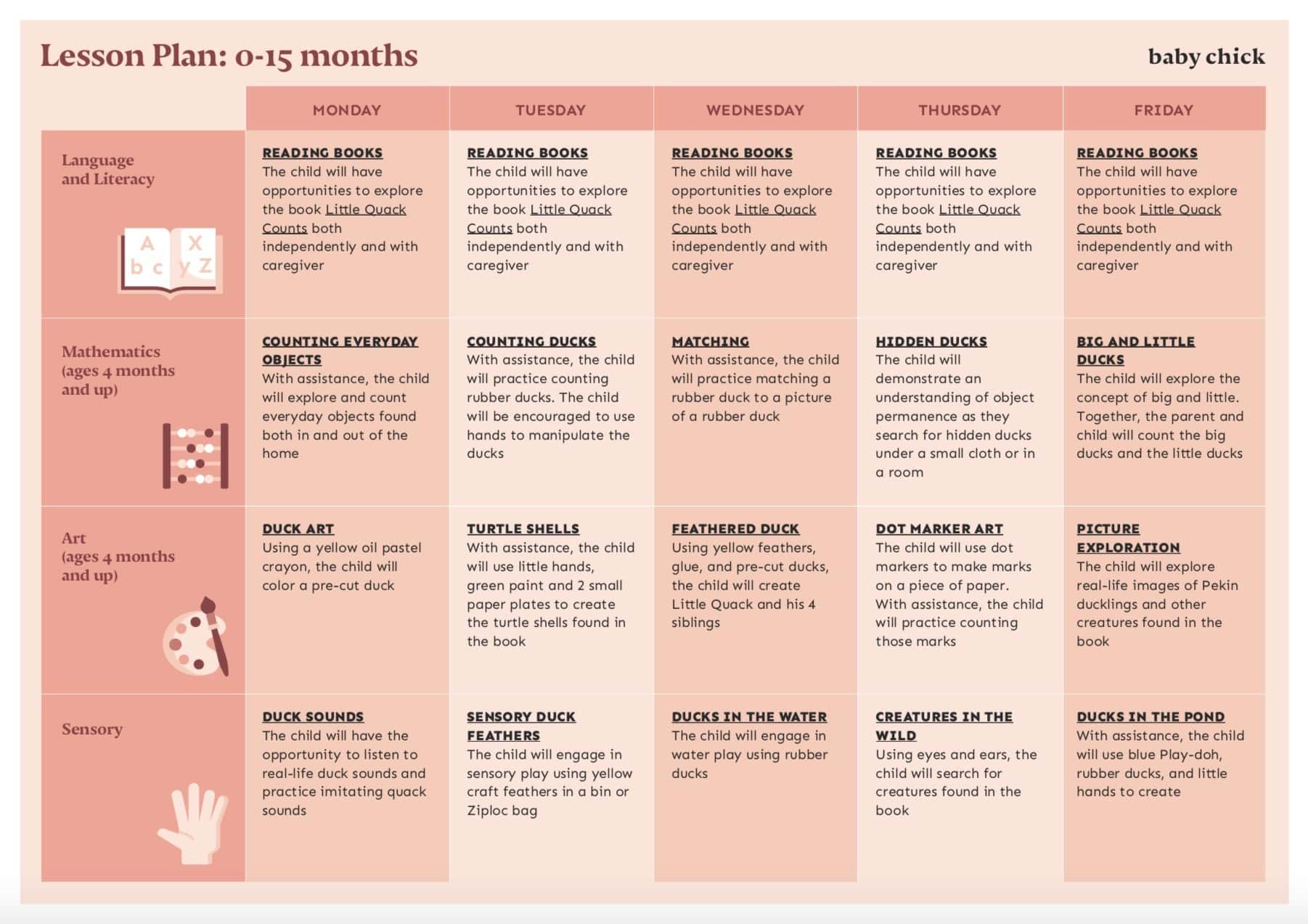
Learning Opportunities In Action
Language and Literacy
Reading books
Spend 5-10 minutes reading Little Quack Counts by Susan Thompson with your child while taking time to narrate what is happening in the story beyond the words in the book. Allow your child to explore the book independently and observe them. Use those observations to help you create guided learning opportunities.
Materials: Little Quack Counts by Susan Thompson
Mathematics
Counting everyday objects
Take a moment to count everyday items in or outside your home during your child’s day. For example, while taking my son for a walk around the block, I would often count a few of the flowers we would come across.
Materials: Everyday objects in and outside the home (i.e., shoes, stuffed animals, crayons, etc.).
Counting ducks
Provide your child with the opportunity to explore rubber ducks. Encourage them to use those little hands to manipulate the ducks. Help your child point to the duck, identify them by name or sound, and count them.
Materials: Yellow rubber ducks (varied sizes are ideal).
Matching
Introduce your child to the concept of matching with the help of a rubber duck and its corresponding picture. Before the learning experience, you will want to snap a photo with your smartphone or camera and print the image. Talk with your child about how the two ducks look similar and establish the matching connection by placing the rubber duck on top of the picture.
Materials: Rubber duck and its corresponding picture.
Hidden ducks
Help your child gain or reinforce the concept of object permanence while working with rubber ducks. For younger infants, allow them to manipulate the ducks with their hands and then place a small cloth over the ducks. Encourage your child to practice various fine motor skills to uncover them. Older infants and younger toddlers can demonstrate their understanding of object permanence by searching for hidden ducks around a room. This is a great opportunity to practice gross motor skills (crawling, standing, and walking) and build vocabulary.
Materials: Rubber ducks, small cloth (depending on age).
Big and little ducks
Introduce the concept of big and little to your child using rubber ducks of various sizes. Identify which ducks are big and which are little and allow the opportunity to explore them in more detail. Mention how the big duck’s features are bigger than the little duck’s. For an added challenge, you can help your child practice matching little ducks and big ducks together.
Materials: Rubber ducks (varied sizes are ideal).
Art
Duck art
During art time, encourage your child to manipulate the yellow oil pastel crayon to make marks on the pre-cut duck. Take some time to narrate what your child is doing as they are doing it and connect to the finished product being a duck. Use hand-over-hand guidance to help your child make marks if needed.
Materials: Yellow oil pastel crayon, pre-cut duck shape.
Turtle shells
Create the shells of the two turtles found within the book using paper plates, green paint, and little hands. Younger infants may do better working with their feet rather than their hands. In that case, you can use tape to hold the plates in position and then hold your child upright while they explore the cool texture of the paint on their feet. Once complete, you can reinforce counting skills by helping your child count the shells.
Materials: Green paint, a paintbrush, masking tape (if desired), and two small paper plates.
Feathered duck
Help your child create a duck using a pre-cut duck shape, yellow craft feathers, glue, and a paintbrush. Pour a small amount of glue onto a small paper plate. Encourage your child to manipulate the paintbrush to spread the glue around the duck shape. Then encourage those little hands to place the yellow feathers on the glue and press them in place. Depending on age, hand-over-hand guidance and/or modeling may be necessary to introduce certain skills.
Materials: Pre-cut duck shape, yellow craft feathers, glue, small plate (for glue), a paintbrush
Dot marker art
Provide your child with the opportunity to explore dot markers both with and without assistance. Dot markers can be heavy, so some hand-over-hand guidance may be necessary for younger infants. Use those dot markers to practice making marks on a blank piece of paper. As your child works with the dot markers, this is also an excellent opportunity to introduce colors and practice repeating those color words. Once done with the dot markers, help your child count the dots.
Materials: Dot markers and a blank piece of paper.
Picture exploration
Before this learning opportunity, you will need to print real-life images of creatures found within the book by conducting a Google image search. When ready, explore these images with your child. Allow your child the opportunity to manipulate the pictures as they carefully explore the differences between them. Use the opportunity to work on identifying the creatures in the images by name/sound as well.
Materials: Real-life images of creatures found within the book.
Sensory
Duck sounds
Spend some time with your child listening to duck sounds. Depending on your child’s age, you can also practice imitating duck sounds and identifying the duck by name.
Materials: Ducks sounds. These can be found on YouTube.
Sensory duck feathers
Use yellow craft feathers to create a sensory experience for your child. For a no-mess experience, place the feathers in a Ziploc bag and encourage little hands to manipulate the bag. Taping the opening of the Ziploc shut may be necessary for added reinforcement. For young toddlers, use an open container and allow them to feel the softness of the feathers against their skin.
Materials: Yellow craft feathers, Ziploc bag, or small empty bin.
Ducks in the water
Engage in some water play with your child as they continue their exploration of rubber ducks. This learning experience can be done during bath time or outside with a small container of water.
Materials: Rubber ducks, water.
Creatures in the wild
During this activity, infants and toddlers will use their eyes to search for creatures found within the book. This is one of my favorite activities with my one-year-old because he would watch my face so intently after I brought his attention to a sound that I heard. We would look carefully with our eyes and listen with our ears until we found something that matched the creatures in the book. Once we found something, we would work on identifying it by name/sound. This learning opportunity is also a perfect time for a field trip to a local park or nature preserve!
Materials: Little Quack Counts by Susan Thompson and a sense of adventure!
Ducks in the pond
Help your child set the scene by using blue Play-Doh to act as pond water. Encourage your child to use fine motor skills to flatten the Play-Doh into a usable surface. Once finished, allow your child to practice using the rubber ducks on the makeshift pond and manipulating them.
Materials: Blue Play-Doh, rubber ducks. Or learn how to make homemade playdough.
The Takeaway
The beauty behind creating learning opportunities at home is that they work around your family’s schedule! Daytime, afternoons, evenings, or weekends—you have the power to create these opportunities at an optimal time for both you and your child.
In a typical preschool setting, the day begins and ends at a certain time. If your child attends preschool, being absent could result in missed learning opportunities. You can help keep that momentum going by filling the gaps with learning opportunities at home. If your child stays home, you can now implement lessons usually accomplished within the preschools.
Creating learning opportunities at home is as easy as having the materials, a little bit of time, and some imagination!













